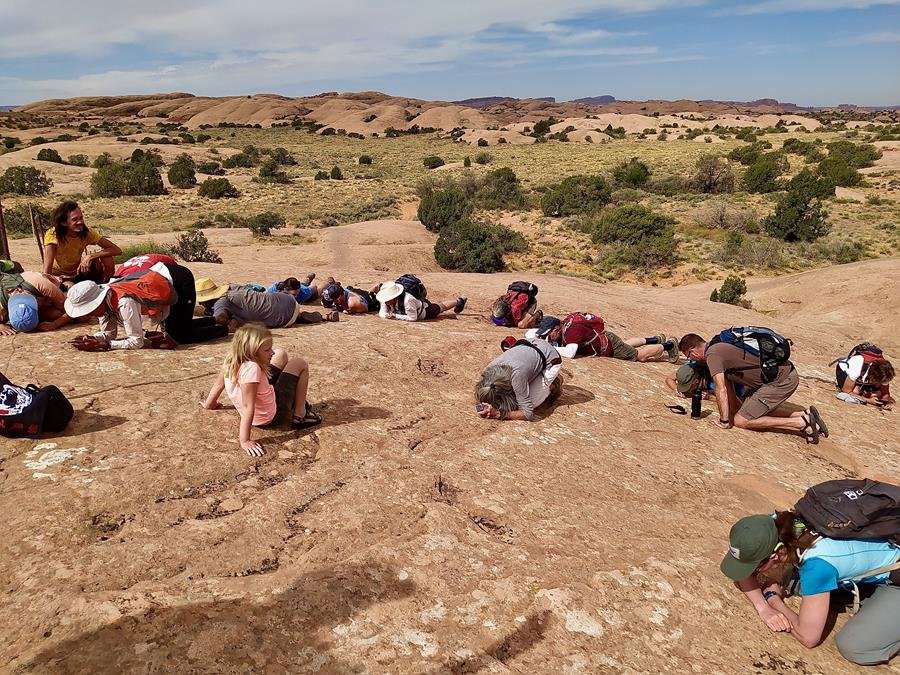Grouse Poop or Creative Cryptograms?
Plus, see our Great Salt Lake Shorelands Preserve report in the news, mark your calendar for our Earth Day training, and join our current projects!
Lichenologist Steve Leavitt and others search for lichen in the Utah desert. Photo courtesy Steve Leavitt.
In 2019, our team participated in a Bioblitz with BYU lichenologist Steve Leavitt, which resulted in a new lichen discovery. "As we looked, I recognized the genus of one lichen, but it was such a wacky, weird shape. Here we are in the middle of Glen Canyon, and we find this new lichen whose closest relative is in Scandinavia!”
Discoveries like these are important disruptions in a world dominated by human perspectives and hierarchies. Read our recent blog post to enter the wild world of lichens (some of which, yes, look like grouse droppings).
Save the Date: Community Science Project Training!
It's nearly time for our community science warm weather project trainings! This year, we're excited to announce that they will be held in person at the Natural History Museum of Utah.
Join us all day OR for your particular project(s) of interest. The agenda is as follows:
8:30am - Registration, Refreshments, & Welcome
9:30am - Boreal Toad Project
11:00am - Utah Pollinator Pursuit
12:30pm - Lunch & Prizes
1:30pm - Wasatch Wildlife Watch Training*
3:30pm - Trail Camera Demo (outside)*
You can also explore the museum with other volunteers and enjoy a snack during trainings you're not attending. Let us know if you plan on joining so we can plan for food.
*Please note that Wasatch Wildlife Watch training attendees will need to have their spot on the project confirmed beforehand. If you're hoping to join that project this year, indicate your interest here and watch for an email!
Note that the training will be recorded for those who cannot attend in-person.
An Update on Rosy-Finch Counts
Many of our project biologists and volunteers have noticed that there seem to be fewer rosy-finches at bird feeders this winter. Since portions of the West are having one of the snowiest winters in years, we're wondering if our flocks went further south to find better sources of food. Reports of rosy-finches on eBird are slim in the winter, especially from remote desert regions.
We compared the size of Gray-crowned Rosy-Finch flocks from three years of December Feeder Counts to track this pattern.
Figure by Janice Gardner.
Learn more about the Rosy-Finch Project on our project page. A HUGE thanks to all our volunteers faithfully surveying at bird feeders!
In the News: Shorebird Reports and Great Salt Lake
Headline on a recent article by the Nature Conservancy.
Our team works passionately on multiple issues tied to Great Salt Lake. From riverscape restoration to our Migratory Shorebird Survey in Utah, our team cares deeply about the lake and communities who depend on it--from shorebirds to humans.
Check out The Nature Conservancy's recent article highlighting the work of Sageland Collaborative staff. Findings include bird activity as potentially linked to the shrinking lake.
2022 Volunteer Survey (5-10 mins)
Photo by Sierra Hastings.
Did you volunteer on one of our projects at any time in 2022? We want to hear from you! Take our brief end-of-year survey by Friday, February 10 for a chance to be entered into a drawing for a YETI mug, YETI bottle, or Sageland Collaborative hat.
Your response helps us as we plan for coming years and continue to improve our work. Take the survey!







